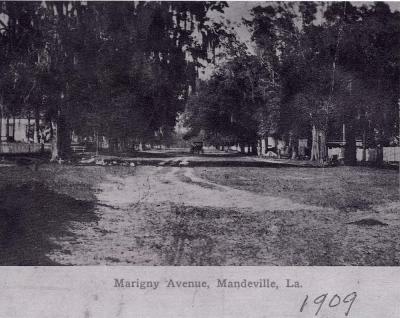Marigny Avenue
Marigny Avenue. As the grandest of Mandeville's streets at 100 feet wide with neutral ground, it is fitting that it should bear the name of the town's founder: New Orleans Creole (French and Spanish descendents born in Louisiana) aristocrat, statesman and real estate developer Jean Bernard Xavier Philippe de Marigny de Mandeville (1785-1868).
On the town's first map by Louis Bringier in 1834, the avenue is identified as Cours Marigny, Route de Washington Cite. In land transfers through the 19th and into the 20th centuries, it variously appears as Cours Washington, La Route Publique, Marigny Road, Lower Washington, and Chemin Marigny. The name was formalized as Marigny Avenue in the 1980s.
Now some information about the man himself:
Many have promoted a view of Bernard Marigny, son of Lousiana-born Pierre Philippe de Marigny de Mandeville (1750-1800) as a spoiled Creole aristocrat who laid waste to a vast family fortune by eating, drinking and gambling it away. The truth is very different and far more interesting.
Bernard Marigny was born into enormous wealth. However, Marigny devoted a long career in public life to some distinctly populist ideals. Among these was his tireless protection of the rights of French Creole culture and community before, during and after Louisiana became a state (1812).
Marigny played a consequential role in the Battle of New Orleans (1814-1815) as a member of the Committee of Defense working to directly support General Jackson's command. As an elected member of the Louisiana House and Senate, Marigny participated directly in Constitutional Conventions in 1812 and 1845. He was a perennial candidate for the office of governor.
He was a Creole aristocrat who was anything but a dissipated bon vivant. Energetic and creative, almost two centuries before architects and planners started beating the drum of "new urbanism", Marigny envisioned and brought forth the Faubourg Marigny in New Orleans. Later, based on his experiences at Fontainebleau Plantation, he laid out the design of what became the town of Mandeville (1834) with a set of development covenants that were, even by today's standards, amazingly progressive.
Marigny, the Creole aristocrat and father of Mandeville, could well be considered as one of Louisiana's most interesting and consequential figures.


